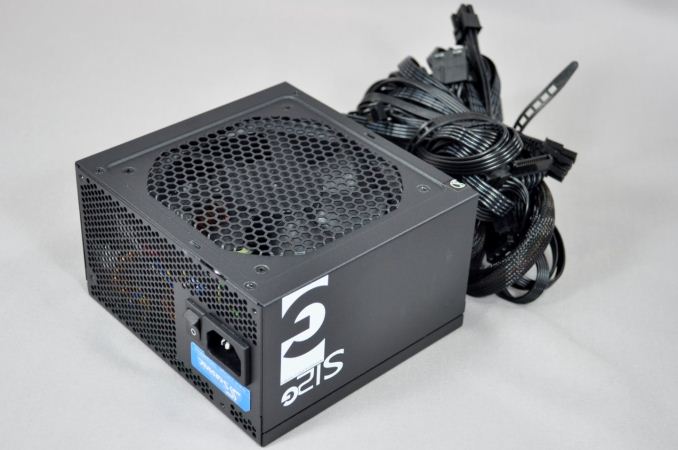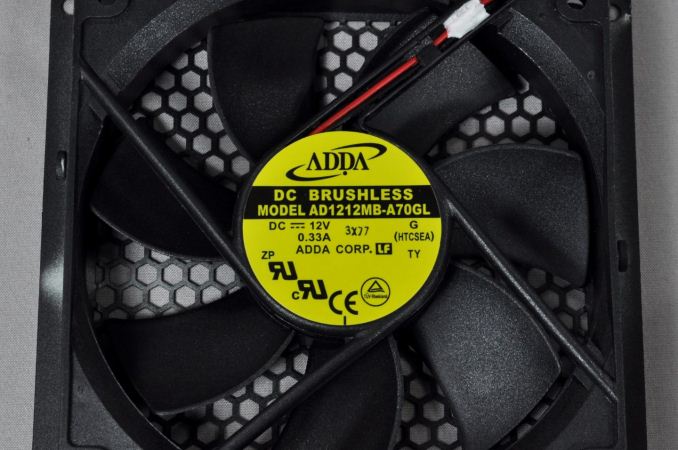Seasonic S12G 650W Power Supply Review
by E. Fylladitakis on February 28, 2014 2:20 PM EST- Posted in
- Cases/Cooling/PSUs
- Seasonic
- 80 Plus Gold
External Appearance
The Seasonic S12G sports a small, typical ATX-sized (140mm) chassis that has been sprayed with a matte black paint. Some effort has been made to improve the appearance of the power supply, albeit not all of the measures can be considered successful. Seasonic uses all-black ribbon cables, with the exception of the 24-pin ATX cable that uses typical color-coded wires and sleeving. A blue sticker has been placed on the rear of the unit, where it will be visible from the back of a case once the PSU has been installed. Oddly enough however, the company sprayed the series logo in white on the right side of the chassis, where it will be facing the right side panel of a case. It goes without saying that it will not be visible inside the vast majority of the cases currently in the market. On the other hand, the sticker with the specifications of the PSU has been placed on the left side of the chassis. No effort has been made at all to enhance the top side of the chassis visually, so in a bottom-mounted location users with case windows will simply see a black surface.
Internal Design
We were surprised the instant that we opened up the chassis of the S12G 650W unit. The unit is cooled by an ADDA AD1212MB-A70GL fan, unlike the majority of Seasonic's other models that use SanAce fans. The particular fan model is high quality, featuring a "Hypro" liquid bearing and with a maximum speed of 2050 RPM, yet it is no SanAce. When you have to compete in the mainstream market and even a few dollars can make an immense difference on sales, you have to keep the retail price as low as possible, which is most probably why Seasonic went with the ADDA fan for the S12G. Note also that as this unit has no fanless mode, it does not require a fan with extraordinary specifications (e.g. a very low starting voltage).
It is obvious that the OEM behind the S12G is Seasonic, as the company designs, manufactures, and markets their own units. We spot four heatsinks; the smallest one handles the rectifier bridge, the one near the edge of the PCB cools the active PFC components, and those on each side of the main transformer handle the inversion and conversion transistors of the primary and secondary stage respectively. The input filter begins on the PCB attached to the back of the receptacle, but continues on the main PCB until the input of the rectifier bridge. We spot a total of six Y capacitors, two X capacitors, and two filtering inductors, which form an excellent intake filter.
In terms of component and build quality, Seasonic does not let us down. The primary capacitor and most of the smaller capacitors are supplied by Nippon Chemi-Con, with some Rubycon electrolytic capacitors after the secondary side heatsink as well. Everything is well shielded and secured with glue, ensuring the mechanical cohesion of the unit. The inductors are glued and also tightened with cable ties, in order to minimize the chance of vibration-generated noise (also known as "coil whine"). The quality of the soldering is very good, well above what we would consider average. There are a few spots where excessive solder has been applied, but that hardly is worth commenting on in a $90 MSRP PSU.






















77 Comments
View All Comments
E.Fyll - Sunday, March 2, 2014 - link
Because an audio recording will be:a) distorted by the sound recording device,
b) distorted by the sound playing device and,
c) entirely unrelated to the original volume.
Even if you consider that a) the recording device is perfect and b) the playback device is perfect, plus d) that the sound file is uncompressed and of very high quality, the end result will be affected simply by how high is the volume knob of each user.
That's misleading, so I'm not going to do it. It has no practical meaning over me simply stating how the unit "sounds like" in the text.
pintos - Sunday, March 2, 2014 - link
How are you measuring the sound level? Wouldn't that have the same problems?pintos - Sunday, March 2, 2014 - link
Also, same question for the rest of your equipment. Don't they also have measuring issues yet they're fine to publish?emn13 - Saturday, March 1, 2014 - link
You're wrong.frequency spectrums aren't hard to read: flat or smooth are plain noise (white or otherwise), and bumpy is tonal. If you include a time component it gets a little messier, but then, we're not talking high-precision sound here, just a general feel of the music; even that may be acceptable.
Furthermore, it certainly doesn't take any high-cost equipment: any bog-standard computer mic will do a surprisingly good job, and if you spend a *little* effort getting a decent (not necessarily best-of-the best) mic and verify the system's quality using a a simple frequency response plot, you can get more than adequate quality for this purpose for at most a few hundred dollars - likely less, but it's not worth your time at that point.
E.Fyll - Sunday, March 2, 2014 - link
Well, frequency spectrums are very hard to read, they do are entirely useless to the standard consumer (the same "type" of noise can actually sound a lot different) and if you think that you can do it with just a "computer mic", well, I have nothing more to say...If I attempt to do anything like that, I would have wasted time and resources on something entirely useless and ridiculously inaccurate. Sorry, that I cannot do. Call me an arrogant perfectionist but I would rather not do something at all if I cannot do it correctly.
quest for silence - Monday, March 3, 2014 - link
"A" in dB(A) stands for "A-weighted"; the further explanation as "the part of dB range that your ears can perceive" is just meaningless.quest for silence - Tuesday, March 4, 2014 - link
"A" in "dB(A)" stands for "A-weighted", so that the subsequent state: «i.e. it is within the part of the dB range that your ears can perceive» is meaningless.g.davis - Saturday, March 1, 2014 - link
Ya, it'd be nice if AT can get numbers for reliability of PSUs somehow. Well, actually, for any electronic device they cover (ie. HDD, SSD, RAM, notebooks, GPU, motherboard, complete systems, etc.). However, I doubt that's possible aside from an occasional external report.Archipelago - Saturday, March 1, 2014 - link
I have had a Seasonic 400W fanless and it's totally quiet. The only time I heard it is the faint click when I shut down.mark28 - Saturday, March 1, 2014 - link
Thanks for the info. This makes me wonder if Seasonic has quality control issues which is far worse than my noise issue. Maybe they just don't test for noise output during quality checks but that kind of ignores a large part of the people who buy fanless parts specifically to reduce noise regardless of efficiency.The noise from the fanless Seasonic PSU I had was so annoying that I replaced it with an actively cooled Corsair one. The difference was like listening to a crying baby and the static noise you hear in between radio stations. Even if it's quieter in volume level (ie. several rooms away), the crying of a baby is way more annoying than static noise.